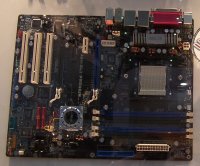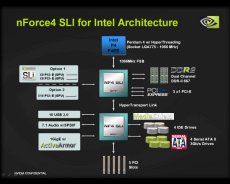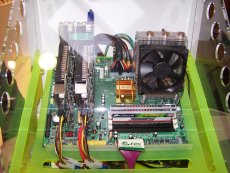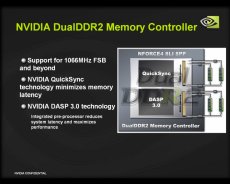NVIDIA
Like ATI, NVIDIA’s CeBit was also about chipsets, although with the success of nForce4 they had a very positive story to tell. In only a few months of the release of nForce4 NVIDIA have captured nearly 50% of the market share of the K8 platform sales. The success of SLI also appears to have caught even NVIDIA a little off guard as over 350,000 of those nForce4 platforms sold have been of the SLI variant and of the nForce4-SLI boards that were sold within systems over 80% came with two graphics boards already in place.
As we mentioning in our recently look at NVIDIA’s SLI technology, the platform is continuing to evolve and ASUS have their new A8N-SLI Premium desktop board on show. This board replaces the selector card with an integrated circuit switch which can now re-route the PCI Express graphics lanes from single board to dual board within software, without having to open the case.
However, the big news for NVIDIA at CeBit was the launch of their first Intel chipset, now officially dubbed nForce4 Intel Edition. Rather than aiming for top to bottom line of products for the Intel platform, NVIDIA appear to have realised that there is less opportunity in the Intel space than there is on the AMD platform as they will be competing against Intel themselves, and for this reason NVIDIA are targeting nForce4 Intel Edition firmly in the enthusiast space, offering high performance, overclockability and SLI capabilities.
Because on the Intel platform its it the job of the Northbridge ("SPP") to handle the memory interface, unlike the AMD64 platform which integrates this into the CPU, NVIDIA’s nForce4 Intel Edition platform moves back to a more traditional two chip Northbridge / SouthBridge approach. Future platforms for both Intel and AMD may go back to this format in the future so that the Southbridge functionality can be shared between the two platforms without the need for making different chips.
The Southbridge ("MCP") contains many of the communication functions, most of which can be found on the nForce4 AMD platform. NVIDIA have packaged up their disk and RAID support up into the MediaShield name in order to better convey that the onus is on both disk performance and reliability. Although MediaShield doesn’t have Intel MatrixRAID technologies, which can spread different RAID types on different partitions of the same disks, they do have RAID5 capabilities which when used with 3 hard drives can bring slightly increased performance and resilience.
Although some of the specifications found on the Intel platform differ slightly from those on the AMD there is nothing, feature wise, in the silicon on the nForce4 for Intel chipset that doesn’t already exist in the nForce4 AMD platform and in time NVIDIA will look to update the two to be inline with each other. The primary difference overall is that of the memory support as on the Intel platform NVIDIA now have control over this element. The controller itself is a dual channel DDR2 controller supporting speeds up to 667MHz, and can also handle various asymmetrical memory density configurations, at a slightly reduced performance, much like Intel do with their "Flex Memory Technology". The memory controller also features two elements that NVIDIA call QuickSync, which is supposed to reduce the effects of memory latency, and DASP 3.0 which is implements some pre-fetching capabilities.




